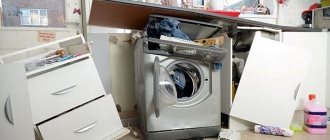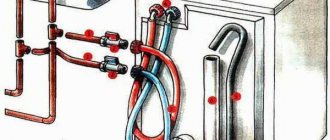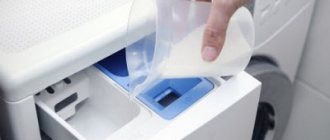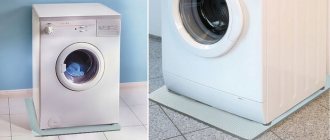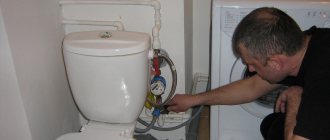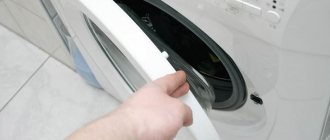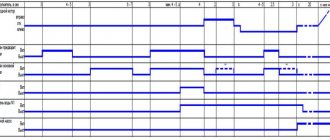A washing machine makes life at home a lot easier. Even if you are a man and live alone, you will not have any problems with laundry. However, after several washes, this washing device can not only move from its place, but can jump quite strongly. This happens with almost all machines, expensive, cheap, installed by a master or with your own hands, and it can be really annoying. Personally, I struggled with mine, which was completely working, for several years and finally found a solution. Today there will be an article about this, as well as a video version. So let's read and watch...
In this article I will tell you all the reasons why a machine can jump and wander (leave from the place where you installed it) - from major breakdowns to incorrect installation. Well, in the end there will be a real solution to the problem. So, let's start with breakdowns
My recipe
In general, I looked up a lot of things on the Internet, checked the shock absorbers, counterweights, and level in my washing machine, but nothing helped, I walked and walked.
Especially strong if there is little laundry (when there is a lot of laundry, there was practically no noise, just correct balancing). In general, I once came across special anti-vibration pads on the floor, under the legs of the car. Many people may also call them damper legs, dampers, spacers, etc. In general, there are many names, but the essence is the same - they should remove unnecessary vibrations and the machine should not jump.
I went to the well-known store “LEROY-MERLIN” and bought these pads for some ridiculous money (about 150 rubles). They are made of durable, either rubber or rubber with plastic, you can’t tell.
I came home, installed and started the machine. Imagine my surprise that the machine, even with a small amount of laundry, jumped much less (once 5-6 times). I thought this was a victory!
BUT it's so simple. The pads themselves reduce vibration much more strongly, but do not completely eliminate it. As a result, after 3 - 4 days of intensive washing, the machine still moved a little (from the place where I put it).
The design needed to be completed. As a result, on one forum there is an elegant and cheap solution, you need to glue 3M tape (over the entire area) under the two front “spacers”! Take “3M” because it is strong and adheres very strongly to almost any surface.
As a result, now the machine stands like a glove, as it was set at the same level, so it is on it. If there are vibrations, they are dampened by these “stands”. What’s interesting is that there is a kind of recess in them and the machine cannot get out of them. I advise everyone - IT WORKS.
Watch the video, here I tried to tell you in more detail.
This is where I end, I think my experience was useful to you. Read our construction blog, there will be a lot more interesting things.
I did and checked everything, but the machine still jumps
Previously, cars were much more stable. For example, my mother has a SAMSUNG machine that is 15-20 years old. So it stands like a glove, doesn’t jump anywhere and doesn’t walk around the kitchen (they only replaced the shock absorbers after 12 years and that’s it).
And my new LG just jumps around like a goat, although it seems like I did everything as it should: the level, the floor, and removed all the bolts, but still, it walks on the tiles, just catch it! Why and what to do?
Everything is simple here. Previously, the machines were wide, for example, my mother’s was about 60 centimeters long, the drum was made narrow but long, and even had a belt drive (the belt works as an additional damper). Such machines have correctly distributed weight. So they stand like a glove.
My new one is much narrower, only 40 centimeters, it has a wide but short drum, and direct drive. Accordingly, the weight distribution of the laundry is much worse. In simple words, the radius of the drum is larger, and if there is not much laundry and it is crumpled in one corner, then a strong imbalance results. And since the body is narrow, it cannot cope with this imbalance! So your car jumps, even a new one straight from the store. The question arises - what to do?
On a wooden floor
It will not be possible to install equipment correctly on an old wooden floor without special preparation of the base. Before installing on a wooden floor, make sure it is strong enough to support the weight of the machine. If it is strong, it won’t hurt to strengthen it with additional fasteners (screws, self-tapping screws) - it can weaken under the influence of vibrations. If there is any doubt about the sufficient strength of the boards, they must be dismantled to prepare a new base for the device. The work is performed in the following order:
- mark the dimensions of the machine on the boardwalk with an allowance of 4 cm in each direction;
- dismantle this section of the floor and lay supports under the sagging trimmed boards;
- make formwork and cover it with polyethylene for waterproofing;
- lay the reinforcement grid inside the structure;
- make cement mortar and pour it into the resulting mini-foundation with the top mark just above the floor level.
The final hardening time of the solution is about a month, so the work should be done in advance. After this, you can install the washing machine on the manufactured foundation in the usual manner.
If it is impossible to dismantle the weakened section of the floor, you can raise the base on which the unit will be installed above the floor surface. This is done by installing four sections of pipes (at the corners of the machine contour), resting through holes in the floor on the main floor. The upper part of the segments must be in the same horizontal plane. On them you need to lay a sheet of plywood or chipboard 2 cm thick in dimensions slightly larger than the size of the machine in plan. After fixing the sheet on tubular supports, the structure is ready for use.
Motor and belt
There are two types of washing units. These are direct drive washing machines, and those that are attached between the motor and the drum with a belt.
The first type is more convenient, the machine does not shake. Even over time, it is in perfect condition only if the jumps and vibrations are not associated with springs, suspensions or bearings.
The second type of machine, where the drum is attached to the motor using a belt, often breaks. Because of which? Because the belt is worn out.
Due to its weakening, the drum shakes. Because of this movement, the machine may not just vibrate, but jump and make loud banging sounds. This means that the damage is serious, the drum is hitting the body.
The washing machine jumps for several reasons:
- the belt is worn out;
- the pulley fastening is broken;
- the engine became loose;
- the shaft is deformed;
- the crosspiece is damaged;
- The belt is not installed correctly.
All these reasons are related to the motor and belt. The washing machine may vibrate strongly and may even jump during the spin cycle.
If the reason is related to the motor, call a technician. You should not repair such parts yourself. In addition, the master always gives a guarantee.
And the belt can be replaced yourself. When washing machines jump and move during the spin cycle, they must be placed in such a way that there is free access to the back wall.
Then unscrew the bolts, remove the back cover and immediately see the belt that requires replacement or tensioning
You need to get rid of it carefully. To do this, pull it towards you and rotate the pulley at the same time
Then put on the new belt. How to do this? First put it on the motor shaft, then pull it onto the pulley and rotate it at the same time. That's all. Check that the belt is tight.
Screw the back wall into place, put the machine in its original position and test. If the drum moves normally, there is no vibration or jumping, everything is done correctly.
Incorrect installation and operation of the device
The reasons why the machine rattles and jumps during the spin process are very diverse - from improper installation of the unit to failure of its important components. And while some of the causes can be eliminated on your own, eliminating others will require the help of a qualified specialist. To begin with, we suggest you figure out in which cases you can cope with the problem without outside help.
Shipping bolts not removed
If the problem was discovered immediately after delivery of the new equipment, it may not be a problem with the device at all. Often, during installation of the unit, buyers forget to unscrew the shipping bolts located on its rear panel. Such bolts firmly fix the washing machine tank to protect the device from damage during transportation.
When installing a new washing machine, be sure to unscrew the shipping bolts
After removing the parts, the drum hangs freely on springs, which dampen vibrations of the device during washing. If the bolts are not removed, the rigidly mounted drum will vibrate violently, causing rapid wear of many internal components. The number of shipping bolts may vary between different models of equipment, so we advise you to check the instructions before removing them. In order to remove the parts, you will need a wrench of the appropriate size. For washing machines from Indesit or Zanussi, its size is 10 mm, for devices from Samsung, LG or Bosch brands - 12 mm.
The device is unstable on the base
Another reason for the strong vibration of the washing machine during the spin cycle may be its incorrect installation.
First of all, pay attention to the surface on which the device stands: it should be hard and monolithic (ideally, a concrete floor or tile). Most often, machines bounce on a wooden floor: at high speeds, it bends under the weight of the device, increasing the vibrations created by the drum
In rare cases, the machine may jump because the floor in the room is too smooth and slippery. In this case, you can cope with the rumble by placing a rubber mat under the device or by sticking special anti-slip stickers on its legs. If you can't find similar stickers in the store, use double-sided construction tape.
You can restore the washing machine's stability by adjusting the height of its legs.
We also advise you to pay attention to how tightly the legs of the device are screwed. Sometimes during operation their fastenings become loose, which leads to instability of the machine.
To check that the legs are secure, simply rock the machine with your hands. If it is “limping”, then the supports should be adjusted and secured in the correct position with a lock nut. You can also reduce the length of the legs by screwing them deeper into the base of the device. This way you will achieve greater resistance of the unit to vibrations.
The laundry is unevenly distributed in the drum
To avoid many problems during operation of the device, the developers advise you to always follow the recommendations for the weight of the loaded laundry. Uneven distribution of items can overload the drum and cause the machine to rattle during the spin cycle. If you suspect that the rattling noise is caused by an imbalance, follow these instructions: stop the spin cycle, remove some clothes from the machine, spread the remaining laundry evenly around the drum, and then restart the spin program.
Do not overload the washing machine with laundry
What to put under the washing machine to prevent it from jumping
To securely secure the washing machine to the floor, you can try weighing down the equipment. Some people put a stack of books and a large package of washing powder on the top cover. Such measures help reduce vibration and increase stability, but too much weight can push through thin material. It is better to use special stands that reduce the shaking of the machine during washing.
Anti-vibration stands
Such products help level the floor surface and provide stability to the body. The anti-vibration stands have a nice appearance. There are various models on sale that differ in color and shape. They are easy to install and there is no need to turn off the equipment. The machine is tilted and a product is placed under each leg. The stands are made of material that can place equipment in a horizontal position.
Anti-vibration mats
They look thin, but they help set up the device for normal operation - they reduce vibration during spinning and reduce noise levels.
The porous product consists of 2 layers with different characteristics:
From the rugs available on the market, you can choose a product based on texture, shape and color. Shahintex universal mats are suitable for any washing machine. They are easy to clean and do the job well. High-quality Proflex products are environmentally friendly. They have no smell. Anti-vibration mats and mats from Mattix-Vibromats are highly resistant to wear. They are suitable for use in low temperature conditions, in rooms without heating.
If the washing machine moves and jumps, it can damage nearby objects or cause the hose that supplies water to become disconnected. As a result, there will be a flood in the room. Mechanisms experiencing a destructive load will lead to more complex and expensive repairs, so the device must be securely fixed.
Source
How to properly install a washing machine and prevent it from jumping
After purchasing and turning on the washing machine for the first time, we may encounter problems such as vibration and “jumping.” This trouble creates a lot of difficulties for us. Especially if you mount the unit under a sink or install it in a bathroom with a tiled floor, you risk damaging their integrity, which will lead to additional costs. And if the drain hose pops out from the “jumps,” then your flooded neighbors may also have to spend money on repairs. There is no need to talk about the discomfort from the constant noise and rumble during the spin cycle. Therefore, today we will talk about whether it is possible to install a washing machine so that it does not jump and in what ways to do this.
How to get out of the situation
What makes a washing machine jump? As a rule, this is the relief of the floor covering on which it is installed. Therefore, you will definitely have to ensure that the device stands as level as possible. If you cannot achieve this, then the constant “dancing” of the machine during the spin cycle will lead to a gradual unwinding of the machine’s legs. Therefore, first of all, you need to take care of the quality of the stand.
Wood will help you achieve your goal. In particular, you can use:
Place the washing machine so that it stands level, and the problem will solve itself, at least until the stands wear out, you can forget about the existence of this problem.
Important external factors
When installing and connecting the device yourself, external factors such as the floor covering at the installation site and air temperature are taken into account.
Flooring
As mentioned above, the surface where the machine is placed must be durable.
We list the main types of floor coverings and their advantages and disadvantages from the point of view of installing a washing machine.
Tree
Not the best basis for installing the device. Firstly, wooden flooring is rarely perfectly level, secondly, it “plays” under load and, thirdly, it deteriorates when exposed to moisture.
If you still have to install the machine on a wooden floor, then it must first be strengthened to reduce vibration. A washing device with a depth of at least 45 cm is installed on the tree.
Laminate
Laminate flooring, like parquet boards, is laid on a waterproofing or soundproofing base. Such a substrate is elastic and will cause vibration of the floor covering during operation of the unit. In addition, parquet and laminate deteriorate when exposed to water.
Linoleum
Installing a washing machine on a wooden floor covered with linoleum is the least preferable option. It contains all the disadvantages: softness, slippery surface, hidden floor irregularities. When installing the device on such a surface, choose only a full-sized unit with a depth of 60 cm.
Ceramic tile
A ceramic tile floor is a good base for a washing machine. It is smooth, durable and well dampens vibration from a running drum.
The only drawback of this coating is its smoothness. During operation, the machine may slide on such a floor and shift. A special rubber mat or pads under the machine’s feet will help solve this problem. You can purchase such accessories at a hardware store.
Concrete
Concrete is perhaps the best option for installing a washing machine. It is hard, smooth and not at all slippery. A device of any depth is installed on such a coating.
Ambient temperature
Another important external factor is the air temperature where the machine is installed. It should not be below +10°C. You should not choose a place such as an unheated garage, loggia or veranda for the device. The problem is the lack of ventilation in such rooms and low temperatures in winter.
During operation, the washing machine generates heat. If the room is cold, moisture condenses on the inside of the machine, damaging the electronic components. Condensation also causes the appearance of black fungus and rust.
How to connect the washing machine correctly
To ensure trouble-free operation of the washing machine, it is necessary to install it correctly, choosing the optimal location. Before first use, be sure to read the instructions in order to operate the device safely. The rules for connecting equipment consist of the following steps:
- choosing a place where the washing machine will be located;
- preparation for operation;
- connection to water supply;
- sewer connection;
- connection to the electrical network;
- installation of equipment.
First of all, you need to choose a location for the device. If the bathroom is small, then the machine can be placed in the kitchen or bathroom. The main thing is that the floor in this place is level, so that it is possible to connect sewer and water pipes, as well as connect the device to electricity. As for the bathroom, excessive humidity can negatively affect the parts, thereby shortening the service life of the equipment. Using the machine in the bathroom is not very convenient, considering that washing can last for hours. If the washing machine is placed in the kitchen, the beautiful appearance of the shiny front panel may be ruined by splashes and stains.
The device preparation stage includes the removal of packaging materials and other shipping parts, such as staples and bars
Important: Do not turn on the washing machine before you have removed the transport bolts, as this may cause it to malfunction. If the kit contains plastic plugs, they should be installed in place of the bolts
It is important to understand that connecting equipment to the water supply is a responsible matter, since improper implementation of this item can lead to water leakage. Usually a water hose and the necessary fittings are supplied, but its length may not be sufficient to connect to the pipe in the required place
There are two ways to solve this problem: purchase a longer hose or connect the pipe directly to the machine. If you decide to go the first route, then when buying a part, you should take the length with a margin so that the tube does not get stretched, much less twist, stopping the water supply.
Connecting a washing machine to the sewer is possible in two ways: fixing the pipe to the drain of the bathtub or washbasin, or connecting the pipe to the sewer pipe. The first option does not provide reliability, since the hose may be accidentally touched and water will spill onto the floor. It is optimal to connect the device permanently, in which case the reliability of the connections will be guaranteed. When connecting household appliances at this stage, it is necessary to take into account the length of the drain hose and the presence of a special siphon, which will prevent sewage and unpleasant odors from entering the device.
When connecting the device to the mains, please note that the machine consumes quite a lot of energy. Therefore, this procedure must be carried out carefully, taking into account the fact that the machine is in contact with water and current. To ensure safe operation, it is recommended not to use extension cords, but to supply electricity using special plastic boxes. The use of sockets with the appropriate degree of electrical safety is considered the best option.
After you have connected all the required hoses and removed the shipping bolts, you need to level the washing machine using the adjustable feet. It is recommended to place the device on a concrete surface to ensure a stable position. Do not place various objects under the legs in an attempt to level the equipment.
Remember that vibration during the spin cycle may indicate serious problems with the device.
Level adjustment of legs
The drum of the machine, rotating even at low speed, creates vibration. If the laundry is unevenly distributed, it becomes stronger. Vibration is dangerous because it wears out machine parts faster. How to install a washing machine so it doesn't jump? The answer is simple - align the legs.
To begin with, by adjusting the height of the legs, the machine is brought into a stable state (so that it does not swing). After this, take a building level and install it parallel to the front wall. The front legs are adjusted so that the air bubble is exactly in the middle.
Then the level is alternately moved to the side walls of the machine and the rear legs are adjusted. The end result of the work should be a position where the body of the machine is stable, and the level shows a strictly horizontal position both in front and on the sides.
Installation without level
If you don’t have a building level, you can use a glass or saucer of water instead. Place the dishes with water on the top lid of the washing machine and adjust the legs so that the water in the glass or saucer is at the same distance from the edge of the dish.
Operating tips to reduce vibration
Do not overload the drum when washing. The suspension system is designed to work with a certain load. Excess will lead to excessive vibrations, and in the long term to premature failure of components.
Before starting, distribute things evenly around the circumference of the drum. There are models that can do this on their own, but still help them - artificial intelligence is not that smart yet.
If your machine is a top-loader, you can keep something heavy on it, such as a laundry basket. This will increase resistance to vibration.
Place the machine at a distance of at least 5 cm from the walls so that in an emergency it does not damage them or itself.
Use the correct mode
A washing machine has many modes, and they are needed for a reason. If you are constantly using the same routine, it is time for you to change your approach, otherwise you may ruin your things. Don't be tempted to throw everything in the wash at once and wash it at the highest temperature to get the task done quickly. This harms both the car and clothes. Wash delicate items separately from heavily soiled items for best results. Also, check label directions.
Habits that destroy a girl's charm. Eternal tension - for men
Neighbors ask me the secret to the beauty of my dacha flowers. Banana helps me out
We decorate a plastic flower pot with a tree: I laid out the pieces in the form of a mosaic
We buy legs for the washing machine
Now retail outlets sell a lot of all kinds of anti-vibration feet for washing machines: they are united only by the functional load that these devices perform. We will tell you about their advantages and disadvantages:
- Anti-vibration rubber pads. The simplest option: they do not have superpowers. Sometimes these legs are made from silicone.
- Paws for washing machine. Devices identical to the legs. Their differences are only in their unusual “appearance”, so this is a more expensive option for legs for a stylish car.
- Or you can buy a rubber mat that you can lay under the washing machine.
Installing the legs
Everything is very simple here: adjust the washing machine so that it stands perfectly level on the floor, using a level. Place rubber caps on the legs of the device. Anti-vibration stands have a larger diameter than the legs of the device: therefore, silicone devices will be easy to put on and the vibration of the device will stop. How to adjust the stands and legs of the washing machine? Just spin them clockwise or counterclockwise. This is how you will lengthen or shorten the legs. So the question of how to regulate it will disappear by itself. To have a complete idea of how the legs are put on, look at the photos and videos on our page.
Counterweight defects
The constant position of the washing machine and the reduction of vibration are ensured by a special heavy block placed inside the body. It is made of concrete or plastic and is attached to the tank with bolts. According to the standards, there must be two counterweights that can be destroyed over time. Sometimes the concrete counterweight cracks and a piece breaks off, throwing off the balance.
Fasteners on parts can weaken due to vibration when there is excessive load on the drum (often due to loads of laundry above normal).
You can guess about problems with counterweights if the machine knocks and shakes during operation, but there is no grinding noise. Repair consists of inspecting the integrity of the counterweights, replacing them with new ones, tightening the fasteners or replacing them.
Wear of springs and shock absorbers (dampers)
The longer the life of the washing machine, the less elasticity of the springs fixing the tank becomes, and their ability to control vibrations is lost. To fix the problem associated with worn springs, you need to replace them all with new ones.
Another reason why washing equipment bounces a lot is faulty shock absorbers. They, like springs, muffle the swaying of the drum during intense rotation. Their failure results in tank subsidence. You can check the condition of the shock absorbers yourself: open the machine door and slightly pull the tank towards you, and then release it. If it starts to move to the sides and does not fit neatly into place, then the shock absorbers will need to be replaced with new ones. In addition to shaking, spinning can be accompanied by tapping - these are faulty elements hitting the body.
Problems with dampers usually result in the breaking of the plastic covers that surround the tubes or plates extending from the tank. The process of replacing broken covers also requires experience and skill. In addition, there is a problem with selecting a suitable lining; it is more advisable to replace the dampers with new ones.
Why does the washing machine jump?
The first cause of strong vibrations may be transport bolts that have not been removed. They firmly fix the tank inside the housing so as not to damage it during transportation. Before starting work, bolts and other fixing elements must be removed. It is strictly prohibited to operate the machine with them. The next reason for vibration is the uneven distribution of things in the tank. If you start the device with an empty tank, it will not vibrate. The same thing will happen if you distribute things perfectly evenly - in an even layer around the entire circumference of the tank. In reality, such a distribution is impossible to achieve; even those evenly distributed at the beginning are mixed during the washing process.
Faulty tank suspension and support bearings. Loosening of the counterweight.
The purpose of the system of springs, dampers and counterweight is to make the natural frequency of the tank much lower than the frequency of its rotation. This reduces the amplitude of vibrations and the amount of vibration transmitted to the body. To better understand the content of the previous paragraph, remember: at the beginning of the spin cycle, the body of the loaded machine sways more strongly, and then, with an increase in the rotation speed of the tank, the swaying turns into a slight trembling or, with the correct distribution of the laundry, practically disappears.
Swing the tank - after that it should make no more than one oscillation and stop. Otherwise, the shock absorbers are faulty and must be replaced.
Open the casing, inspect the elastic elements - metal ones should not have deformations, rubber ones should not have tears or cracks. Defective parts must be replaced! Check the counterweight fastening - if it is loose, tighten the nuts.
Faulty bearings. There should be no squeaks or knocks when the equipment is operating. Rotate the tank by hand and rock it from side to side. If you detect squeaking or beating, replace the faulty parts.
Troubleshooting Tips
The following recommendations will help you solve some problems with your machine, which begins to shake during the spin cycle:
- You should always read the instructions first. It indicates the main technical problems and their manifestations, as well as the location of all structural elements.
- If the washing machine is under warranty after purchase, you should not try to disassemble it yourself. These actions may serve as grounds for refusing further interaction on the issue of breakdown.
- Before performing any manipulations, you need to drain the water, then disconnect the device from the power source.
- Finding out the reason for jumping during push-ups should be done in the direction from simple to complex. First, check the installation of the machine, its sliding, and the distribution of the laundry. Then the presence of foreign things in the tank and transport fastenings on the wall. Only after this they begin to inspect the internal parts.
- When disassembling, it is advisable to mark the elements in the sequence of their removal, sketch a drawing of the location, or take photographs of the process so as not to confuse the parts.
- All complex and dangerous actions should be carried out only by specialists. Fixing the problem will cost more, but the machine will work and the owner’s health will remain intact.
Transport bolts
The first reason why a washing machine jumps during spinning or washing is forgotten shipping bolts.
The unit is delivered in special packaging to prevent damage to the equipment. If it is enough to surround a TV with a foam plastic frame, then this is not enough for a washing machine.
For transportation, special bolts are used. They are necessary to fix the tanks rotating inside.
If transport bolts are not used, they will damage the walls of the equipment. That is, these are kind of fuses that protect it from internal damage.
If you recently bought a device, and it starts jumping during the spin cycle, the reason may be the bolts that you forgot to remove.
They do not prevent things from being washed, the drum will spin, but not as quickly as it should. If you do not notice this problem, the components will immediately begin to wear out.
What can I do to prevent the washing machine from jumping? It is necessary to remove the fastenings used for transporting equipment. They are located on the back of the equipment. The main thing is to dismantle them correctly.
All such fasteners number from 2 to 4, some install 6 fasteners.
How to remove shipping bolts:
- Turn the washer towards the light.
- Take a key of the appropriate size. Loosen the fasteners.
- Remove the bolts from their mounting sockets by slightly tilting the machine downwards to the rear, otherwise the fasteners may fall inside the device.
- Close the holes with special plugs.
That's all. Dismantling will not take much time, and knowledge of how to properly remove shipping bolts will be useful in the future.
Place for washing machine
The reliability of its operation and the period of trouble-free operation depend on where the washing machine will be installed. Typically, the following rooms are used to place a washing machine:
- Bathroom. Ideal in all respects. Connected communications are located at arm's length, and the flooring is hard - tiles or concrete.
- Kitchen. This room is convenient in terms of connecting the device to the network, but the floor covering may be soft, which does not contribute to the stability of the machine. A wooden floor can sag, and then it needs to be reinforced.
- Hallway. This option is rarely used. In addition to problems with coverage, there is also the distance from pipes and sewers, which will require additional steps for their installation.
Other accommodation options are much less common. This could be free space under the stairs, a utility room or a storage room.
When placing the washing machine, you need to pay attention to the position of the device relative to surrounding objects. Contact of the device body with a bathtub or sink, cabinets and other objects located within its radius should be avoided.
Direct contact with them initiates the destruction of the source of vibrations, that is, the machine itself or the objects it affects (furniture, plumbing fixtures).
Call the master
In case of complex equipment breakdowns, you need to call a specialist from a washing machine repair company. By giving preference to responsible companies that have been operating for years, you can protect yourself from scammers and unprofessionals.
The cost of repair work does not include the price of new parts. The average prices in Moscow are as follows:
- removal of transportation bolts – from 1,400 rubles;
- replacement of springs - from 2,500 rubles;
- replacement of shock absorbers - from 2,900 rubles;
- removal of a foreign object – from 1,700 rubles;
- replacement of counterweight – from 2,300 rubles, etc.
The final price for LG repairs is determined on the spot. After the washing machine is restored to working order, a test run is performed and the technician issues a guarantee for the work performed.
What can you do on your own?
If everything is clear with internal breakdowns - you can’t do without a specialist, then operational defects can be corrected yourself:
- Before using your new washing machine, make sure there are no transport bolts on the back wall;
- when installing on an unstable or uneven surface, adjust the legs to the level, and install special pads or an anti-vibration mat to minimize noise and vibration;
- Consider the drum load when preparing for washing. Remember that the drum is no more than 2/3 full. A packed tank is just as bad as an almost empty one;
- do not wash small items and bed linen together or use special bags for socks, panties, etc.;
- Do not allow small parts to get inside the tank, otherwise try to remove them using a magnet, vacuum cleaner, hook and other available means.
Reasons for washer vibration
To avoid vibration, it is necessary to install the washing machine correctly. When installing it yourself, carefully study the instructions that come with your purchase. There are several reasons for jumping equipment; if they are identified in a timely manner, costly repairs can be avoided.
New technology
A new machine often vibrates because the bolts securing the drum have not been removed. They are located on the back wall of the machine, there are only 4 of them, and they can be easily unscrewed. If you plan to transport this equipment in the future, it is recommended to save the bolts.
Another reason for a model that bounces a lot is an improperly installed machine. To ensure precise fixation to the floor, it is recommended to use a level. If the equipment wobbles even in a non-working position, then during washing or spinning it will definitely jump.
The cause may be a slippery tiled floor if the machine is installed directly on it.
If the installation is done correctly, but the washing machine still jumps, then the cause may be uneven distribution of laundry in the tank. It is also necessary to correctly calculate the weight of the laundry, taking into account the washing mode.
Before loading laundry, you should check all pockets in your clothing to remove any foreign objects.
If everything is installed correctly, I follow the instructions when loading laundry and selecting a washing mode, but the machine still jumps, then the reason may be its manufacturing defect. It is not recommended to repair new equipment yourself; you should contact a service center for help.
Old car
If the washing machine is no longer new and suddenly begins to vibrate during washing or spinning, then in addition to the reasons listed above, there may be the following:
Troubleshooting yourself
To eliminate some malfunctions, it is not necessary to take the device to a service center; you can do everything yourself. To do this, you need to do the following:
- If foreign objects get behind the drum, you need to bend the rubber seal of the hatch on the front panel, fixing the drum. After this, you should hook the item and pull it out. If you can’t do this, the only thing that will help is removing the heating element and disassembling the automatic machine, which is best left to a professional.
- If the laundry is unevenly distributed, you need to perform an emergency drain of water and unlock the hatch. Next, you should take out the laundry, separate them from each other and carefully place them in the drum. If overload is observed, then remove some of the things from the machine.
- If there is a problem with installation, you need to determine the correct height using a level and adjust the legs of the washer. You can also level the floor or lay down a sheet of chipboard, fiberboard, or anti-vibration pads. Using a rubberized mat will also help if the device slides on the surface.
- If there are transport bolts, you need to turn the machine with the back wall towards you and unscrew 3 or 4 fasteners with a wrench or pliers. In some cases, there are more fasteners, and they are located under the top cover, so it is better to check the instructions first. In their place are installed the plastic plugs supplied. The removed bolts should not be thrown away; they will be useful when moving or rearranging during repairs.
- If you have problems with the shock absorbers, you need to unscrew them and try to compress them. Since their task is to dampen vibrations, movement should be difficult. If this is easy to do, it means that both structures need to be replaced. If only one is corrected, the stiffness will be different and the load will be distributed unevenly.
- If there are difficulties with the counterweights, you need to remove the machine panel (using pliers, a screwdriver, a wrench) and inspect the counterweights. If they crumble, then buy and install new ones. If it is not available for sale, you can tighten the parts with metal plates or glue them together, although this is a rather complicated option. When the counterweights look intact, it is worth examining their mountings, as well as the springs. If they break, they are replaced, but if they are intact, the bolts are tightened.
- To resolve the issue with the electric motor, you need to remove the back panel and try to tighten the fasteners. Also, removing the far cover will allow you to determine the condition of the belt leading from the engine to the drum. Other actions with the motor and the programmable part of the device cannot be carried out independently.
- Bearing failure can only be repaired by a service center.
Shock absorbers
The first and quite serious breakdown is the shock absorbers. Usually there are two of them (rarely four), they hold the drum from below. If they don't work new, then it's just a defect and needs to be replaced under warranty. BUT they mostly fail due to prolonged use (like shock absorbers on a car).
At the same time, the machine loses its dampening properties and begins to jump and rumble; many write that it still wanders either throughout the kitchen, or in the bathroom or bathroom (depending on who it is).
It happens that these shock absorbers simply break, one of the fastenings simply breaks. In any case, you need to either disassemble the body or turn the machine on its side and see if everything is in order. If there is a break, that’s one thing, we just buy a new one and install it, but if there is no break, but “walking and rumble” occurs, then the shock-absorbing elements need to be checked:
- Unscrew
- We try to compress and unclench them. They should walk “stiffly”, that is, they should not compress or unclench easily. This is a shock absorber, it dampens vibrations, and therefore if there is free movement, it means it is not working properly.
If you can’t determine whether it works or not, go to the store, get a new shock absorber and try to compress it (I think then all your questions will disappear).
Technical problem
If the problem persists after cleaning, moving, and checking, the machine's knocking and rattling sound sounds like an expensive repair. You can’t do this without the help of a master. What could be the reasons for extraneous sounds associated with equipment breakdown?
Wear of shock absorbers, springs, bearings
Over time, moving elements exhaust their service life, which can cause noise and equipment jumping:
- spring wear. They record and control drum vibrations. Over time, they require replacement, and the tank with faulty springs may hit the body. As a result, the car jumps and rumbles;
- Damage to shock absorbers is the cause of shaking and sagging of the car tank. There is no point in changing one or part of it; it is better to replace everything at once. Checking the serviceability of the dampers is simple: when you try to pull the drum towards you or press on it, it will vibrate and then fall into place. If this does not happen, then repair is needed;
- bearings have failed. In this case, in addition to uncharacteristic vibrations, you can hear a metallic grinding sound during operation. This occurs due to the penetration of moisture and the appearance of rust on the rubbing elements. In this case, operation of the machine is not recommended; bearings must be replaced.
Destruction of the counterweight or fastening
Inside the body of the washing machine, manufacturers install heavy counterweights - plates that provide stability and dampen vibrations during spinning. When the slab is partially destroyed, the fragments move or fall deeper, causing a rumble inside the housing during operation. The problem will be solved by replacing the counterweight unit or adjusting its fastenings.
Engine malfunction
This is a serious breakdown; in some cases it is better to purchase new equipment to replace the old one. Often a malfunction in the engine is caused by a short circuit or constant operation at maximum power, which is preceded by a malfunction of the water sensors and drum speed control. The specific cause can only be identified through diagnostics by a qualified technician.
Attention! Independent attempts to identify the cause of the breakdown and repair the engine lead to failure of the heating element. And if the washing machine is under warranty, you will be denied free service after intervention yourself.
Manufacturing defects
Rarely, but factory defects occur when machine components initially do not work correctly. You can correct the situation at a service center or place of purchase after confirming the fact of a manufacturing defect. In such cases, the seller replaces the equipment with a working analogue.
Machine design
Fact: Narrow washing machines produce more noise and vibration than full-size models. In this case, the manufacturer sacrificed sound insulation for more compact dimensions. Another nuance is that narrow models have a smaller support area, so stability during an intensive cycle is less, which means it will jump more.
Reasons for the movement and noise of the machine during spinning
There are factors that cause the washing machine to vibrate and jump. Some require scrupulous diagnostics and labor-intensive and correct repairs. There are some that are easy to detect and eliminate yourself.
Counterweight defects
In order for the washing machine to stand still and vibrate less, there is a special heavy plastic or concrete block inside it. It is bolted to the tank. Normally there should be two counterweights. Over time, they crack and pieces break off, resulting in an imbalance. The fact that they need to be replaced or the fastenings tightened can be judged if knocking noises are heard when the equipment is operating, and it begins to shake.
The springs are worn out
These elements for fastening the tank dampen vibrations of the drum during its operation. During operation, they wear out and must be replaced.
Washing machine jumps and vibrates during spin cycle due to limescale build-up
Many owners are interested in why the washing machine jumps during the spin cycle and what to do in this case. The reason may be a large amount of scale, which slows down the rotation of the drum. Sometimes a special powder cleaner helps. But if after this the equipment continues to vibrate when wrung out, you should call a specialist.
Engine damage or manufacturer defect
The drum rotates thanks to the drive from an electric motor. When its brushes wear out or interturn short circuits occur, the motor begins to move at half its power. This is not enough for a normal spin. The fault can only be determined by a technician after diagnostics.
Unsuitable floor surface
A washing machine that is installed on a floor that is too slippery will run and shake during operation, even if everything is done according to the level. To avoid distortion, it is recommended to place a rubber pad of the same thickness under the legs. You can do this yourself.
Loosening the belt
Those models of machines in which the drum and motor are attached with a belt, the latter will become loose. As a result, the drum will begin to shake. The unit will vibrate, move, and make loud banging sounds. This serious breakdown is related to the motor and requires specialist intervention.
Troubleshooting
The first thing to do if the washing machine jumps during the spin cycle is to check that the installation is correct. The unit must stand on a flat, hard surface, preferably on a monolithic floor. If you place the device on a wooden surface, then vibrations and noise during spinning cannot be avoided.
You also need to check the adjustment of the legs, which can unwind during operation of the machine, which in turn will cause the equipment to lose stability. To avoid such a problem in the future, it is necessary to secure each support with a lock nut.
When installing a new washing machine, users quite often make the following mistake: they forget to remove the transport bolts. They are located on the rear panel and serve to secure the tank when transporting equipment. If they are not dismantled, the machine will vibrate and make a lot of noise when washing, and will soon fail altogether. You can unscrew the fasteners using a wrench.
Be sure to remove the shipping bolts before use.
Once the installation issue has been resolved, it is important to check the laundry load volume. If the clothes in the drum are unevenly distributed, clumped or there is too much of it, this can lead to increased shaking of the washing machine
In this case, stop the machine during the spin phase, distribute the clothes manually or remove a few extra items, and then resume operation of the unit.
If you are still wondering why the washing machine jumps during the spin cycle, remove the top cover of the housing and inspect the special springs that hold the tank on top. They quickly wear out and lose their elasticity, which affects the operation of the unit. Within a few months after purchasing the equipment, the springs may fail. If you have the necessary spare parts, it is easy to replace parts at home.
In machines from Indesit, Bosch, Samsung and models of other brands, shock absorbers designed to dampen tank vibration often fail. You can access them through the rear or front panel of the device (depending on the model). The shock absorbers are attached with bolts or plastic clips: one side to the tank, the other to the bottom of the body. When they wear out, they weaken, causing the washing machine to vibrate strongly during the spin cycle. To replace parts, you need to disconnect the fastenings of the old shock absorbers and install new ones, securely fixing them in place. Replacement is not difficult if you have at least minimal knowledge about the structure of the washing machine.
Proper shock absorbers hold the tank and reduce vibration levels
Often, the washing machine rattles and jumps due to the destruction of counterweights - plastic or concrete blocks that are bolted to the tank and balance it. Over time, fastenings can become loose, resulting in increased vibration and noise. The material used to make the counterweights also matters. For example, an LG machine has concrete parts that often crack or crumble. Plastic blocks are considered more durable and reliable. Despite this, they also need regular inspection, especially if the machine constantly rattles during the spin cycle. Timely checking of counterweights for destruction or loosening of fasteners will help to avoid strong vibration and prevent damage to other parts.
Over long periods of use, the mountings of the counterweights weaken.
When answering the question why the washing machine shakes during the spin cycle, one cannot help but talk about the bearings. These parts wear out over time and become a source of noise, namely squeaking or grinding as the drum rotates. If the problem is left unattended, the bearings will completely collapse, which will lead to free movement of the drum shaft on which they are installed. At the first symptoms of a malfunction, it is worth replacing the supporting part, otherwise the cost of repairs may increase significantly. It is difficult to replace bearings at home, so entrust the work to a specialist.
Only a professional can replace worn bearings
When the washing machine jumps and knocks, it creates discomfort for others and can end badly for the equipment.
In order not to cause the unit to suffer serious damage, it is important to identify the cause of the malfunction at the first symptoms and eliminate it as soon as possible. We hope our recommendations will be useful for those who are looking for ways to cope with the constant rumble and vibration of the device
Correct installation of the washing machine
First make sure the floor is level. At the slightest deviation, the car will slide down the slope. To avoid this, install a special platform securely attached to the floor. It will ensure that the bottom surface is horizontal.
The washing machine is installed so that the top surface is strictly horizontal and the sides are strictly vertical. It is enough to set one surface: horizontal or vertical. Otherwise, the loads will be distributed unevenly, which will cause vibration and constant movement of the washing machine.
Leveling the car
To make adjustments, you need an ordinary level, no more than a meter long, and two wrenches to match the size of the adjusting nuts on the legs. You may need a set of foot pads and a piece of rubber.
Incorrect operation
The washing machine may start jumping due to improper loading. There are some rules you should know to follow in order to avoid vibration:
- Do not load the machine above the designated limit. If it is noticeable that the drum is more than half full, then this is already considered to be exceeding the required volume.
- It is unacceptable to put things in one lump, this will lead to an imbalance of the laundry. Before placing them in the machine, you need to lay out the products.
- If one thing is being cleansed, you should be prepared for strong vibration. It’s better to pause and reload the laundry.
Why the car “jumps” and how to deal with it
Increased vibration is typical for recently installed machines. But sometimes time-tested equipment begins to bounce or even move across the floor. It is necessary to determine the reasons for this behavior of the machine before it completely fails. The following options are possible:
- Before installation, the fastening elements - bolts, brackets - were not removed.
- The floor is not level enough, the machine wobbles.
- On the contrary, the floor is too flat and slippery, then you can put a rubber mat on it.
The most easily resolved problem is that damp laundry has curled up inside the drum into a single lump. You need to stop the machine, distribute the laundry inside it with your hands and continue spinning.
There may also be factors of a technical nature. Only a repair specialist can identify and eliminate them:
- The shock absorbers have failed.
- The springs on which the tank is attached are worn out.
- The counterweight mounts are loose.
- The bearing has failed.
The quality of installation of a washing machine depends not only on the connection of the equipment itself, but also on the choice of installation location. It is quite possible for any person to correctly assess the situation, take advantage of its benefits and compensate for the negative aspects. If communications are available, the installation process itself does not take much time. At the end of it, you need to carry out a test run - washing in an empty machine without laundry. If no extraneous noise is detected, the machine can be used.
